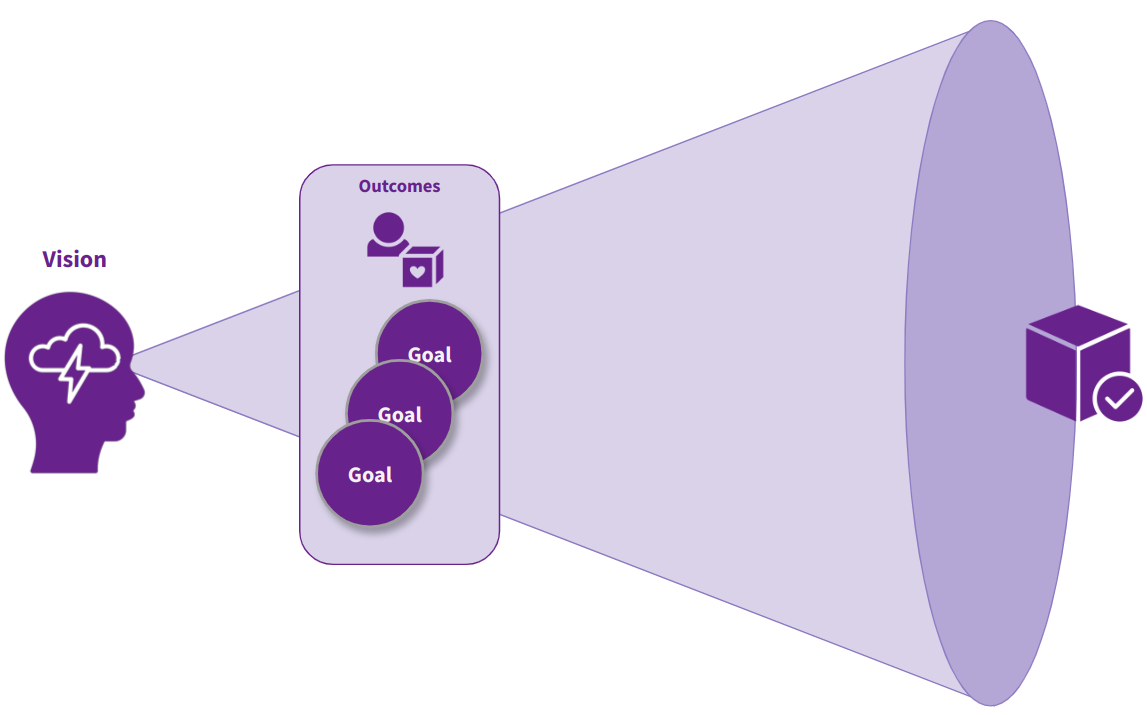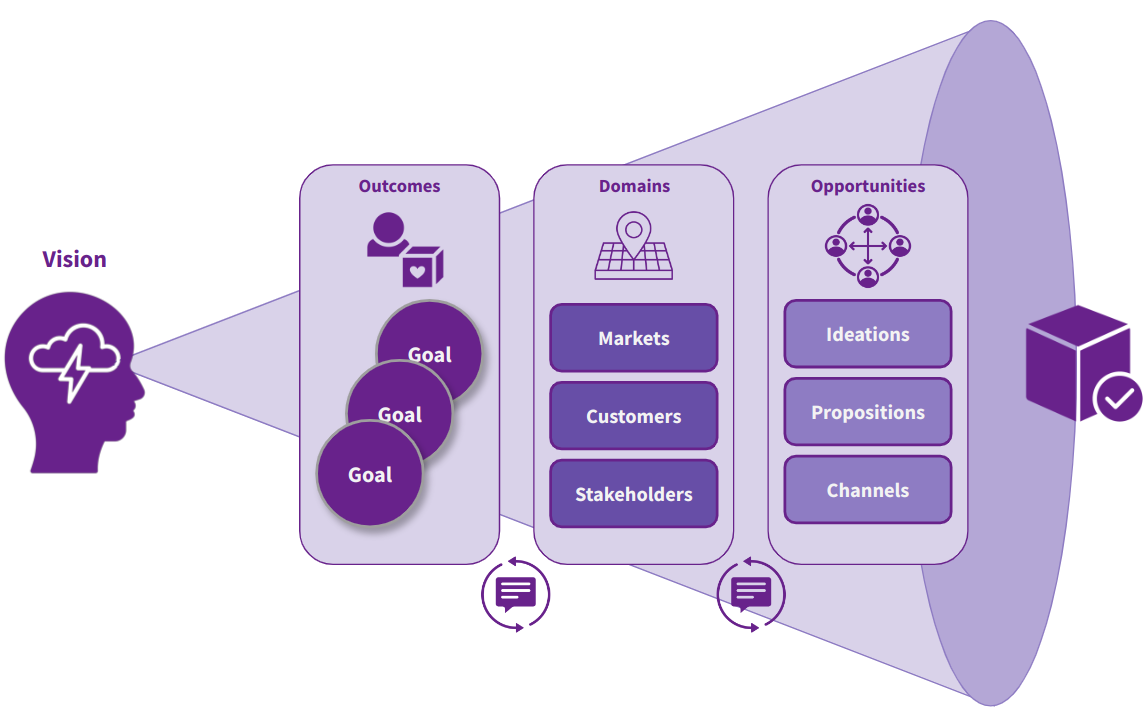Vision to Value: Building a Product Strategy that Wins
Reading Time: 9 mins.
In this rather lengthy post, we’ll explore why a product strategy is essential for your product's success and introduce the “Product Strategy Pattern,”1 a free, open-source pattern we have developed to help product groups refine and evolve their strategic choices.
Contents
Strategy Challenge
Roadmaps vs Strategy
Product Strategy
Beyond Features
Strategy Patterns
Pattern Benefits
Product Strategy Pattern
Example
Iterate, Iterate
Conclusion
What Next?
Strategy Challenge
Product people have often experienced the allure of a sexy product roadmap. It's a comforting security blanket to have a product plan all laid out upfront, with every feature mapped and release milestones dated. What could possibly go wrong with such unvalidated assumptions?
But here's one issue: roadmaps, while helpful, don’t always give us the complete picture. They’re linear and rigid and assume the future is predictable. As anyone who’s tried to correctly predict the lottery numbers knows, this is impossible.
Worse, a common misnomer in product development is the belief that roadmaps are synonymous with strategy. They are not and are totally different.
Roadmaps vs Strategy
A product roadmap outlines ‘what’ will be built and ‘when’ but doesn’t explain the ‘why’ behind those decisions.
Product strategy, on the other hand, is the overarching approach that supports the product’s long-term vision, market positioning, and how we will deliver value. It provides the reasoning and guiding options for a roadmap, ensuring that every option aligns with broader business value and customer outcomes.
Without a well-crafted strategy, roadmaps can quickly become rigid and lose relevance in the face of shifting markets or evolving customer demands. Simply put, product roadmaps are the “how”, but product strategy is the crucial “why”.
Product Strategy
Here is where your product strategy comes in. Instead of just listing out what features we’ll deliver and when, a product strategy provides us with flexible choices to reduce uncertainty, make informed decisions, and stay aligned with our long-term vision.
It’s not about delivering the next feature; it’s about ensuring we have as many options as possible so that every decision we make is informed and moves the product toward success.
“Strategy is an integrated set of choices that positions you on a playing field based on vision and goals in a way that you win.”
Playing to Win: How Strategy Really Works by A.G. Lafley, Roger L. Martin2
Without a product strategy, teams can operate reactively, focusing on short-term wins that fail to contribute to long-term success. Instead, with a product strategy, we provide the foundation for a roadmap, ensuring that every feature and decision supports our outcomes.
It helps teams avoid the failure of building product features for the sake of creating them and keeps the focus on delivering real value to customers and stakeholders.
Beyond Features
Many organizations encounter common challenges when developing a product strategy, such as focusing too much on unvalidated features rather than driven outcomes, failing to align strategy with market realities, or sticking rigidly to a plan despite changing conditions.
This often leads to missed value or wasted opportunities. Avoiding this requires a dynamic approach to strategy, allowing room for adaptation and continuous feedback. In plain words, this means your strategy will change often.
“If your strategy stays static in any way, it is already failing.”
Rickard Jones - Product Coach3
Strategy Patterns
When developing a product strategy, it's easy to follow a specific template or framework. But in reality, product development is often way too complex and unpredictable for a one-size-fits-all solution.
That’s why looking for common strategy patterns is more valuable, with flexible guidelines that allow you to adapt to changing circumstances and make informed decisions based on your product’s unique context.
By recognizing these patterns, you can gain a broader perspective and create a strategy that isn’t locked into rigid steps but instead emerges as your product and market needs change.
Pattern Benefits
No product strategy should be set in stone. The market is constantly evolving, and successful product teams are those that can adapt their strategies to reflect new information. Whether it's shifting customer preferences, competitive pressures, or technological advancements, your product strategy must be flexible enough to pivot while staying true to your overarching vision.
A resilient product strategy plans for success and anticipates challenges and setbacks. By building pattern flexibility into your strategy, you empower your teams to quickly adjust course when needed.
This ensures that your product is not only reactive to changes but also prepared to capitalize on emergent opportunities that will arise.
Product Strategy Pattern
There are already many great approaches to creating a product strategy that enables you to identify patterns for your product. Unfortunately, not all of them have been made freely available for you to use whenever you like.
Here, we present one such approach, the flexible and open-source … “Product Strategy Pattern.”
This pattern supports product teams in moving away from starting with traditional roadmaps and instead towards developing a strategy based upon their own emerging work.
The pattern provides a structured way to generate and evaluate choices by mapping valuable areas such as vision, goals, domains, and opportunities.
Following this approach, product teams can create a strategy that’s adaptive, sustainable and responsive to change. The end result is you have many informed choices to help you win.
Crafting Strategy
Each area is designed to evolve emergent choices, allowing you to refine your approach as conditions change. Let’s explore the pattern elements to see what’s involved in creating our product choices with the pattern.
Vision
A clear and compelling vision is at the heart of any successful product strategy. The vision acts as your product’s north star, providing direction and purpose. It answers the fundamental question:
What is the ultimate goal of this product, and why does it exist?4
A strong vision motivates internal teams and resonates with customers, helping to drive product development toward a shared objective.
Outcomes
Outcomes of real value can be represented as product goals. Product goals are concrete implementations that move your product closer to achieving its vision. These goals should be specific and measurable in terms of actual tangible value to customers, stakeholders and the organisation.
By setting clear goals, teams can ensure their efforts remain focused and that progress is continually evaluated against a defined objective.
While many people advocate delivering product goals simultaneously, product teams should consider developing one goal at a time.
Focusing on one product goal at a time enhances clarity, keeps teams collaborating with each other, minimizes distractions, and improves efficiency and cross-learning.
This singular approach ensures higher-quality outcomes, faster objective progress, and greater overall product success.
“The Product Goal is the long-term objective for the Scrum Team. They must fulfill (or abandon) one objective before taking on the next.”
Scrum Guide5
Hence, in the pattern, they appear on top of each other as they are ordered by importance. We appreciate that this could be a cultural change trigger for many people. Whoopsie!
If you feel the need to juggle multiple product goals at the same time, reconsider whether they are broad enough in scope. Consider merging them into a higher-value, more comprehensive goal to avoid overloading the teams and risking delivering nothing of value!
Domains
Product domains refer to the key people areas your product touches, such as markets, customers, and stakeholders.
Examples of domains could be markets that adhere to regulatory needs, country specifics, and industry factors. Or customers who are users, resellers, or … wait for it … real end customers. And, of course, there are stakeholders, such as owners, shareholders, sponsors, or external partners.
If you need domains other than those shown here, feel free to add your own or remove ones you don’t need. In contrast to goals, working with domains in parallel is desirable.
Understanding these domains is essential to creating a product strategy that evolves with the broader ecosystem in which your product operates.
By mapping these domains, you can ensure that the strategy addresses the right people at the right time and in the right way.
Opportunities
Opportunities represent potential areas where your product can obtain tangible value. These could include ideations (discovery of quick wins, new features, experiments), propositions (offers of differentiators, brand, price, faster delivery) or channels (point of sale, platforms, social media, OEM’s, marketing).
By iteratively identifying and reassessing these opportunities, you ensure that your product strategy remains relevant and capable of seizing emerging trends and unmet customer demands.
Once again, you can examine these in parallel and replace any of them with approaches that increase the value of your product as needed.
By examining these opportunities, we can have many choices about implementing our strategy pattern as it emerges.
Iterate, Iterate
As market conditions, customer needs, and technological advancements evolve, iterating on your product strategy is essential to stay relevant and practical.
Regularly revisiting and adjusting the strategy through ongoing conversations helps ensure it remains aligned with real-world changes and organizational goals.
These feedback conversations with customers, stakeholders and the product teams help promote transparency, enable teams to address emerging challenges, reassess priorities, and validate assumptions with current data.
This iterative approach builds resilience into the strategy, making it adaptable to new insights and fostering cross-functional alignment. It helps teams stay engaged and committed to a shared vision.
The result is a continuously refined strategy that supports sustainable growth and allows for adaptive responses to ever-changing dynamics.
Simply put, you update your strategy by talking. Always talk!
Example
To run through an example, let’s use the company Netflix as everyone knows what they do, and they have a published vision we can use here …
“to entertain the world”
Netflix product vision statement6
Next, we need an outcome goal that supports our product vision.
As a scenario, I made one up to support Netflix’s real vision as so …
Product Goal
“Achieve content that 90% of subscribers feel matches their desires.”
We can now explore which domains this goal could align with.
Domains
Markets
Leverage SWOT Analysis to identify strengths, weaknesses, opportunities, and threats for entering new regions, especially regarding local content regulations.
Use software (e.g., OneTrust) to track and ensure compliance with regulatory standards in specific countries, adapting content to meet local laws.
Tools like Owler can track competitor moves and trends in target markets, allowing Netflix to identify and respond to competitive threats.
Customers
To better understand diverse audience preferences, create detailed personas using data from analytics tools (e.g., Google Analytics, Amplitude).
Utilize behavioural analytics tools like Mixpanel to track user actions and identify content preferences by segment.
Map out the viewer journey to see where users interact with content and drop off, refining recommendations to keep them engaged.
Stakeholders
Maintain profitability while investing heavily in original content and global expansion to maximize shareholder value.
Collaborate with production houses and local studios to create exclusive content for regional markets.
Build partnerships with existing franchises and IP owners to expand Netflix's library of recognizable shows and movies.
Once we understand what markets, customers, and stakeholders need to be served, we can explore the opportunities that can develop in the product to meet their needs and achieve our goal.
Opportunities
Ideations:
Run A/B tests on new content formats like interactive storytelling or short-form content to see what resonates best with different audiences.
Employ tools like UserTesting to gain insights directly from viewers about preferred content features or new content ideas.
Launch a curated experiment of “Netflix Shorts” series featuring 10-minute episodes for quick, mobile-friendly viewing.
Test location-based content recommendations to personalize the user experience further, catering to regional tastes and preferences.
Propositions
Adapt customer identity algorithms to align content offerings with unique selling points that appeal to target audiences, like high-quality international dramas or exclusive documentaries.
Tools like Price Intelligently can help test and adjust pricing models, including tiered and ad-supported options, to find optimal pricing strategies for each region.
Enhance streaming speeds and download capabilities to improve viewing experiences in regions with limited internet connectivity.
Channels:
Promote Netflix gift cards and subscription options in retail outlets worldwide to reach audiences without credit access.
Integrate with smart home devices and gaming consoles to broaden Netflix’s accessibility and cater to home theatre enthusiasts.
Use Twitter, Instagram, and YouTube for teasers, behind-the-scenes content, and fan engagement to maintain high visibility and anticipation for new releases.
The Netflix example illustrates the range of domains and opportunities available to shape your strategy. We can observe that Netflix does many of these already, but not all of them!
These choices will gain further detail and context with actual data, allowing for informed product development. Obtain real data when doing this for your real product.
Conclusion
When leveraging the pattern, avoid adhering strictly to the pattern visual as a process. It’s not a process. Instead, consider organizing by the words alone: vision, goal, domains, and opportunities on a board, without the visual, as this can be equally effective.
Using actual post-its, documents, videos, or slides to enrich these areas is entirely in your gift. Use what you need in the way you need it.
But never forget the feedback importance of iteratively talking about your product strategy … relentlessly.
Whether it's increasing revenue, expanding market share, or improving customer satisfaction, the strategy should support your vision of providing emergent, tangible choices for obtaining value from your product.
Once discovered, how you leverage these many choices is up to you.7
What Next?
You can obtain a pdf open-source version of the “Product Strategy Pattern” from this link here: Product.Strategy.Pattern.pdf
To deepen your understanding of product strategy, consider joining our Certified Scrum Product Owner® — CSPO course. This course will help you take the next step in mastering product strategy and driving your product to success.
The Certified Scrum Product Owner® — CSPO course covers implementing your Strategy with the Product Strategy Pattern, developing a Product Operating Model, leveraging Scrum for innovation, and using AI to make better product decisions.
You can use any of the following links by currency preference to read more about the Certified Scrum Product Owner® — CSPO course details:
GBP: https://www.agileaffinity.com/w/uk/courses/44-cspo-certified-scrum-product-owner
EUR: https://www.agileaffinity.com/w/eu/courses/44-cspo-certified-scrum-product-owner
USD: https://www.agileaffinity.com/w/row/courses/44-cspo-certified-scrum-product-owner






















